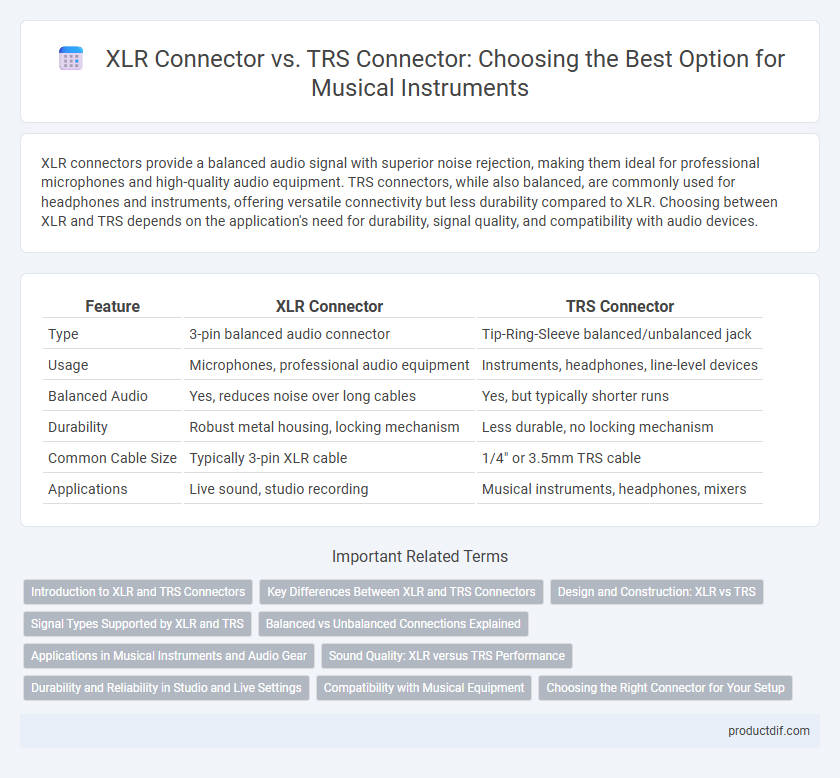XLR connectors provide a balanced audio signal with superior noise rejection, making them ideal for professional microphones and high-quality audio equipment. TRS connectors, while also balanced, are commonly used for headphones and instruments, offering versatile connectivity but less durability compared to XLR. Choosing between XLR and TRS depends on the application's need for durability, signal quality, and compatibility with audio devices.
Table of Comparison
| Feature | XLR Connector | TRS Connector |
|---|---|---|
| Type | 3-pin balanced audio connector | Tip-Ring-Sleeve balanced/unbalanced jack |
| Usage | Microphones, professional audio equipment | Instruments, headphones, line-level devices |
| Balanced Audio | Yes, reduces noise over long cables | Yes, but typically shorter runs |
| Durability | Robust metal housing, locking mechanism | Less durable, no locking mechanism |
| Common Cable Size | Typically 3-pin XLR cable | 1/4" or 3.5mm TRS cable |
| Applications | Live sound, studio recording | Musical instruments, headphones, mixers |
Introduction to XLR and TRS Connectors
XLR connectors feature a circular design with three pins, commonly used for balanced audio signals in professional musical instrument setups to reduce noise and interference. TRS connectors, shaped like a standard 1/4-inch or 1/8-inch plug, support balanced or stereo connections with tip, ring, and sleeve segments. Both connectors are essential in audio equipment for instruments, yet XLR is preferred for microphones and professional-grade cables, while TRS is widely used for headphones and line-level signals.
Key Differences Between XLR and TRS Connectors
XLR connectors feature three pins providing balanced audio connections, essential for minimizing noise in professional microphone setups, while TRS connectors use a tip-ring-sleeve design for balanced or stereo signals, commonly found in headphones and some instrument cables. The robust locking mechanism of XLR connectors ensures secure connections during live performances, contrasting with the friction fit of TRS connectors that can be prone to disconnection under tension. XLR cables support longer cable runs with less signal degradation compared to TRS cables, making them ideal for high-quality sound reinforcement and recording environments.
Design and Construction: XLR vs TRS
XLR connectors feature a robust, three-pin design with a locking mechanism that ensures secure, noise-resistant connections, commonly used in professional audio equipment. TRS connectors, typically 1/4 inch or 1/8 inch in size, have a simpler tip-ring-sleeve design that supports balanced or stereo signals but lacks the locking feature of XLRs. The metal housing of XLR connectors provides enhanced durability and shielding against electromagnetic interference, while TRS connectors offer compactness and ease of use in smaller setups.
Signal Types Supported by XLR and TRS
XLR connectors primarily support balanced audio signals, which reduce noise and interference in professional audio equipment such as microphones and mixers. TRS connectors can carry both balanced signals and unbalanced stereo signals, making them versatile for headphones and line-level instruments. The choice between XLR and TRS depends on the need for noise rejection and the specific signal type required by the audio device.
Balanced vs Unbalanced Connections Explained
XLR connectors provide balanced connections using three pins to carry positive, negative, and ground signals, effectively reducing noise and interference in audio signals. TRS connectors can also offer balanced connections with tip, ring, and sleeve contacts transmitting differential signals, but they are often used for unbalanced stereo connections in musical instruments and audio gear. Balanced connections with XLR or TRS cables minimize hum and electromagnetic interference, essential for maintaining sound quality in professional audio setups.
Applications in Musical Instruments and Audio Gear
XLR connectors are commonly used in professional microphones and audio interfaces due to their balanced signal transmission, which reduces noise and interference in live performances and recording studios. TRS connectors, often found on instruments like electric guitars, keyboards, and headphone outputs, support both balanced and unbalanced signals, making them versatile for patching and monitoring. While XLR connectors excel in delivering high-quality, noise-free audio over long cable runs, TRS connectors provide compact, convenient connectivity ideal for instrument inputs and headphone jacks.
Sound Quality: XLR versus TRS Performance
The XLR connector offers superior sound quality due to its balanced design, which effectively reduces noise and interference in audio signals, making it ideal for professional musical instrument setups. TRS connectors also provide balanced audio but tend to be more susceptible to signal degradation over longer cable runs compared to XLR. For optimal performance and clearer sound reproduction in high-fidelity musical environments, XLR connectors are generally preferred over TRS connectors.
Durability and Reliability in Studio and Live Settings
XLR connectors offer superior durability and reliability in studio and live settings due to their robust metal construction and secure locking mechanism, preventing accidental disconnections during performances. TRS connectors, while compact and versatile for balanced audio signals, are more prone to wear and potential signal loss under heavy use and physical strain. Sound engineers typically prefer XLR connectors for critical applications requiring consistent, interference-free audio transmission over extended periods.
Compatibility with Musical Equipment
XLR connectors are widely used for microphones and professional audio equipment due to their balanced connection, ensuring minimal noise and interference with compatible mixers, amplifiers, and audio interfaces. TRS connectors, offering both balanced and unbalanced signal transmission, are common in studio headphones, instruments like electric guitars, and line-level equipment, providing versatile compatibility across various audio devices. Choosing between XLR and TRS connectors depends on the specific equipment's input requirements and the desired audio quality for live or studio settings.
Choosing the Right Connector for Your Setup
Choosing the right connector for your musical instrument setup depends on the signal type and desired audio quality; XLR connectors provide balanced, noise-resistant connections ideal for microphones and professional audio equipment, while TRS connectors offer balanced or unbalanced connections primarily used for instruments and headphones. XLR connectors deliver superior durability and secure locking mechanisms, making them suitable for live performances and studio environments. TRS connectors, available in various sizes like 1/4-inch and 1/8-inch, offer versatility but may introduce more interference in longer cable runs compared to XLR cables.
XLR connector vs TRS connector Infographic

 productdif.com
productdif.com